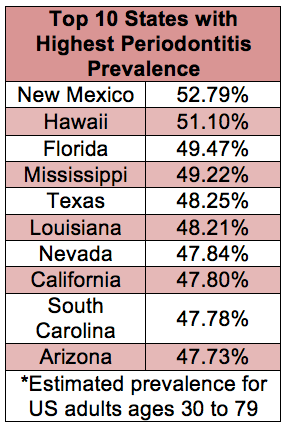New CDC study finds high periodontal disease prevalence in Southern U.S. states
In a recent study published by the Journal of Dental Research, the Centers for Disease Control and Prevention (CDC) estimates that at 52.79% and 51.10% respectively, New Mexico an d Hawaii have the United States’ highest prevalence of periodontal disease.

In a recent study published by the Journal of Dental Research, the Centers for Disease Control and Prevention (CDC) estimates that at 52.79% and 51.10% respectively, New Mexico an d Hawaii have the United States’ highest prevalence of periodontal disease.
The study, entitled “Predicting Periodontitis at State and Local Levels in the United States,” also indicates high prevalence among southeastern and southwestern states, including areas along the Mississippi Delta, the U.S.-Mexico border and among Native American reservations.
The objective of the study was to estimate the prevalence of periodontitis at state and local levels across the United States by using a novel, small-area estimation method. Extended multilevel analyses were applied among adults aged 30-79 at state, county, district and census tract levels.
Other areas with an estimated high prevalence were southern Florida and remote areas of western Alaska. Overall, similar geographic patterns were determined for severe periodontitis as well. The states with the lowest prevalence include Utah (37.69%) and New Hampshire (40.51%).

Additional key statistical findings noted in the study include:
- The prevalence of periodontitis among the states ranged from 37.7% in Utah to 52.7% in New Mexico, representing an estimated 15% disparity in prevalence among states.
- Severe periodontitis ranged from 6.4% in New Hampshire to 11.3% in Louisiana among the states.
- County estimates ranged from 33.7% to 68%, representing a much larger disparity of 34% in prevalence among counties.
- Severe periodontitis ranged from 5.2% to 17.9% among counties.
- National estimates had a mean and median state prevalence of 45.1% and 44.9%, respectively, and 46.6% and 45.9%, respectively, for counties.
- These summary measures compare with the estimated national prevalence of periodontitis among U.S. adults of 44.8% from NHANES 2009-2012.
- Similarly, summary measures for severe periodontitis at state and county levels compared with the estimated national prevalence of severe periodontitis.
More emerging research: Composite restorations of the future may be made of glass
The areas estimated to have the greatest concentration of periodontitis directly correlate with regions that also see high incidence of cardiovascular disease and diabetes, systemic conditions often associated with periodontitis. Moreover, the latest findings are in line with early CDC reports that periodontitis disproportionately affects ethnic minorities, tobacco users, those of lower socio-economic status, and those in areas with sparse access to dental care.
Continue to page two for more...
“This is the first study to model the distribution of adult periodontitis in states and local areas in the United States,” says Dr. Paul Eke, CDC epidemiologist and lead author of the study. Dr. Eke goes on to say, “We found the estimated geographic distribution of adult periodontitis to be highest among southeastern and southwestern states, with concentrated pockets along the southeast, in the Mississippi Delta, along the U.S.-Mexico border, and among Native American reservations. Given how closely associated the risk for periodontitis is with other chronic conditions, such as diabetes or cardiovascular disease, the prevention and treatment of periodontitis represents an opportunity for dental and medical professionals to work together to improve the public’s health.”
More emerging research: Scientists map mouth microbes to pinpoint oral disease origin
The figures are the latest reported by the CDC to determine the burden on periodontitis on the U.S. adult population. The American Academy of Periodontology (AAP) and the CDC, which have collaborated since 2003 to determine periodontitis prevalence, have found that nearly half of all U.S. adults age 30 and above have some form of periodontal disease.
“Periodontal disease continues to be a major health concern for people of all backgrounds,” remarked Dr. Wayne Aldredge, president of the AAP. “The AAP is committed to increasing public awareness of periodontal health and will continue to work with allied dental organizations, educational institutions, and government agencies to reduce incidence of periodontitis in the U.S. adult population.”
More emerging research: Study finds materials that could make stronger dental fillings
The AAP recommends regular flossing, brushing twice a day, and undergoing yearly comprehensive periodontal evaluations for the prevention of periodontal disease, which is treatable and often reversible with proper and timely care from a periodontist. “Individuals who suspect they may have gum disease should schedule an appointment with a general dentist in their area,” continued Dr. Aldredge. “General dentists can provide a referral to a nearby periodontist if disease is present.”
The complete “Predicting Periodontitis at State and Local Levels in the United States” study can be accessed by visiting http://jdr.sagepub.com/.
For more information about periodontal disease, please visit perio.org.
This press release was reprinted from materials provided by Lanmark360. It has been edited for content and length.